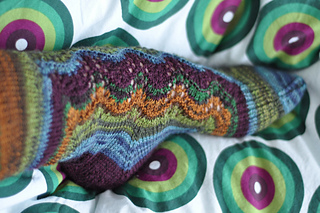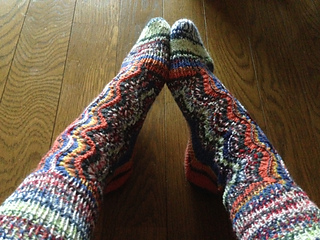patterns > Knitty >  Knitty, Spring + Summer 2014
Knitty, Spring + Summer 2014
> String Theory



























String Theory
There is no need for a major in modern physics to knit these socks, only your curiosity and eagerness to try something new! If you have already knitted heaps of toe-up and top-down socks and want to try something different, this is the sock design to go for this time!
Knitted from the heel on upwards and sideways, these socks explode in a joyful Feather and Fan lace pattern. The instep is then joined at the center as you go. The toe and leg are worked last from either end of your work.
They
The socks not only have a different and interesting construction, they also feel good to wear! The fit is so comfy with the rib hugging the foot and ankle at just the right spots. The wavy lace pattern adds elasticity to the instep -- not to mention that touch of lacy flair!
The innovative architecture and the spiraling lace pattern tickled my mind and were after some calculations very doable, while string theory of modern physics is equally tickling, but stays just out of grasp. I have decided to leave it there, and for today, let’s stick to some inspired sock knitting!
Some words from previous knitters:
“I like socks with unusual construction. The only sock pattern I have done more than twice is String Theory- I have made probably 6 pairs of these. They are worked from the center of the heel up, look weird but fit beautifully.”
“Very nice pattern, will certainly use it again!”
“This is an epic knit! Love the fit… Once on they are lovely! Brilliantly written pattern, although initially confusing as you have no idea how the first one is going to end up as a sock. The second one I did twice as fast”
“I’ve knit several pairs of string theory in zauberball already, and it’s always so much fun seeing how they’ll turn out.”
“It was a very enjoyable pattern to knit, the result for me was a comfortable fit … if one is looking to discover less traditional ways this pattern would be it.”

6424 projects
stashed
7418 times
- First published: March 2014
- Page created: March 11, 2014
- Last updated: November 11, 2024 …
- visits in the last 24 hours
- visitors right now




